Android is known for its unlimited customizations due to the open-source platform. Although Sony Xperia devices aren’t suitable enough to customize or be development-friendly, some do come with AOSP support for further customizations or developments. Before making any system-level customizations, it’s necessary to Unlock the Bootloader of Any Sony Xperia Device.
Well, there are a couple of functionalities or features available on Android that most smartphone OEMs set a limitation for the users. That means even though the feature is available, users may not take full advantage of it or they don’t get additional customization features just like custom firmware. In that sense, geek Android users are always eager to unlock their devices’ bootloader.
Once the bootloader of the Android device gets unlocked, you can easily flash custom or third-party firmware, third-party modules, root access, custom recovery, etc. But remember that all the system-level customizations can be done only after unlocking the bootloader. So, it’s a top priority, and it should be unlocked properly on any Sony Xperia device by following this guide.
Also Read
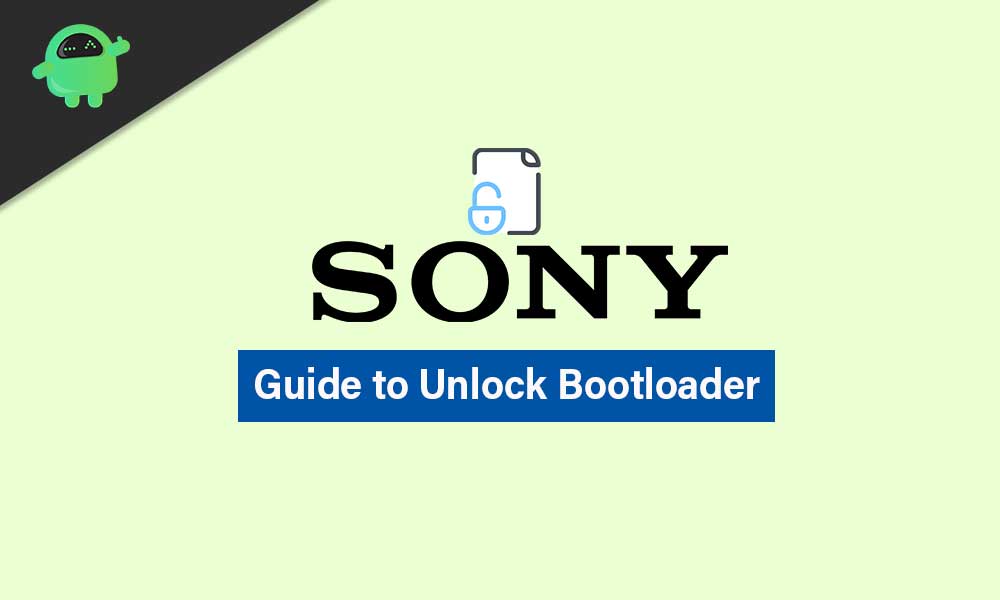
Page Contents
What is Bootloader Unlock?
A device Bootloader is a sort of specific code or program that runs first whenever you turn on your device. It basically sends the hardware-level command to the device system to run the specific boot mode according to the button combination. So, if a user wants to boot the device in the system normally, then only pressing and holding the power button will boot the device.
But if a user wants to boot the device into the stock bootloader, then using the power and volume up/down key combination is required to do so. Now, the stock or a locked bootloader doesn’t have enough options to play with, and it doesn’t allow users to flash third-party files into the system or boot partition as well. Therefore, after unlocking the bootloader, you can install a custom recovery like TWRP, and then you’ll be good to go.
Is there any need to unlock the bootloader?
If you’re an advanced-level Android user or working in development, you should obviously unlock your Android device’s bootloader. But if you’re not tech-savvy or have an extreme level of customization, then we suggest you keep using your device as it is.
So, once you’ve unlocked the bootloader on your Android device, you can easily enable root access on your phone. This will allow you to install rooted apps, remove bloatware or even system apps, overclock or underclock performance, increase battery life, hibernate unused apps in the background, and more.
Here, we’ve listed out all the advantages and disadvantages of bootloader unlocking.
Advantages:
- Easily install third-party firmware or Custom ROM like Lineage OS, Resurrection ROM, etc.
- Enable root access on your device.
- Install a custom recovery like TWRP.
- Increase the battery life.
- Overclock or Underclock the performance.
Disadvantages:
- If not properly bootloader unlocked, the device may be stuck into bootloop or bricking condition.
- The manufacturer warranty may be void.
- You will no longer receive the official OTA updates.
- Unlocking the bootloader will delete all the internal data from your device. [Redownloading or reinstalling existing files aren’t suitable for everyone]
| Sony Supported Devices | ||
| Sony Xperia 5 | Sony Xperia Sola | Sony Xperia E4 |
| Sony Xperia 1 Professional | Sony Xperia SP | Sony Xperia E4 Dual |
| Sony Xperia Ace | Sony Xperia SX | Sony Xperia E4g |
| Sony Xperia 8 | Sony Xperia T | Sony Xperia E4g Dual |
| Sony Xperia 1 | Sony Xperia T LTE | Sony Xperia E5 |
| Sony Xperia 10 | Sony Xperia T2 Ultra | Sony Xperia Go |
| Sony Xperia 10 Plus | Sony Xperia T2 Ultra Dual | Sony Xperia GX |
| Sony Tablet P | Sony Xperia T3 | Sony Xperia Ion |
| Sony Tablet P 3G | Sony Xperia Tipo | Sony Xperia Ion LTE |
| Sony Tablet S | Sony Xperia Tipo Dual | Sony Xperia J |
| Sony Tablet S 3G | Sony Xperia TX | Sony Xperia J1 Compact (D5788) |
| Sony Xperia A | Sony Xperia U | Sony Xperia L |
| Sony Xperia A2 | Sony Xperia UL | Sony Xperia L1 |
| Sony Xperia A4 (SO-04G) | Sony Xperia V | Sony Xperia L2 |
| Sony Xperia Acro | Sony Xperia VL | Sony Xperia L3 |
| Sony Xperia Acro HD | Sony Xperia X8 | Sony Xperia M |
| Sony Xperia Acro S | Sony Xperia X10 | Sony Xperia M2 |
| Sony Xperia Arc | Sony Xperia X10 Mini | Sony Xperia M2 Dual |
| Sony Xperia Arc S | Sony Xperia X10 Mini Pro | Sony Xperia M2 Aqua |
| Sony Xperia AX | Sony Xperia X | Sony Xperia M4 Aqua |
| Sony Xperia C | Sony Xperia X Compact | Sony Xperia M4 Aqua Dual |
| Sony Xperia C3 | Sony Xperia X Performance | Sony Xperia M5 |
| Sony Xperia C3 Dual | Sony Xperia XA | Sony Xperia M5 Dual |
| Sony Xperia C4 | Sony Xperia XA Dual | Sony Xperia Miro |
| Sony Xperia C4 Dual | Sony Xperia XA Ultra | Sony Xperia Neo |
| Sony Xperia C5 Dual | Sony Xperia XA1 | Sony Xperia Neo L |
| Sony Xperia C5 Ultra | Sony Xperia XA1 Ultra | Sony Xperia NX |
| Sony Xperia C5 Ultra Dual | Sony Xperia XA1 Plus | Sony Xperia P |
| Sony Xperia E | Sony Xperia XA2 | Sony Xperia Pro |
| Sony Xperia E Dual | Sony Xperia XA2 Plus | Sony Xperia Pro-I |
| Sony Xperia E1 | Sony Xperia XA2 Ultra | Sony Xperia Play |
| Sony Xperia E1 Dual | Sony Xperia XZ | Sony Xperia Ray |
| Sony Xperia E3 | Sony Xperia XZ Premium | Sony Xperia R1 |
| Sony Xperia E3 Dual | Sony Xperia XZs | Sony Xperia R1 Plus |
| Sony Xperia XZ1 Compact | Sony Xperia XZ1 | Sony Xperia S |
| Sony Xperia XZ2 | Sony Xperia Z1 | Sony Xperia SL |
| Sony Xperia XZ2 Compact | Sony Xperia Z2 | Sony Xperia Z5 Premium Dual |
| Sony Xperia XZ2 Premium | Sony Xperia Z2 Tablet LTE | Sony Xperia ZL |
| Sony Xperia XZ3 | Sony Xperia Z2 Tablet Wi-Fi | Sony Xperia ZL2 |
| Sony Xperia Z | Sony Xperia Z2a | Sony Xperia ZR |
| Sony Xperia Z Ultra | Sony Xperia Z3 | Sony Xperia Tablet S |
| Sony Xperia Z3 Compact | Sony Xperia Z4 (SO-03G, SOV31, 402SO) | Sony Xperia Tablet S 3G |
| Sony Xperia Z3 Dual | Sony Xperia Z4 Tablet WiFi (SGP712) | Sony Xperia Tablet Z LTE |
| Sony Xperia Z3+ (E6553) | Sony Xperia Z4 Tablet LTE (SGP771) | Sony Xperia Tablet Z Wi-Fi |
| Sony Xperia Z3+ Dual (E6533) | Sony Xperia Z4v | Sony Xperia Tablet Z (SGP311) |
| Sony Xperia Z3v | Sony Xperia Z5 | Sony Xperia Tablet Z (SGP312) |
| Sony Xperia Z3 Tablet Compact | Sony Xperia Z5 Dual | Sony Xperia 10 III Lite |
| Sony Xperia 10 IV | Sony Xperia Z5 Compact | Sony Xperia 1 III |
| Sony Xperia 1 IV | Sony Xperia Z5 Premium | Sony Xperia 5 III |
| Sony Xperia 1 II | Sony Xperia L4 | Sony Xperia 10 III |
| Sony Xperia 10 II | Sony Xperia 5 II | Sony Xperia 5 IV |
| Sony Xperia 10 V | Sony Xperia 1 V | Sony Xperia 5 V |
How to Unlock the Bootloader of Any Sony Xperia Device
Before heading over to the main steps, follow all the requirements properly. So, without wasting any more time, let’s jump into it.
Pre-Requirements
Now, before getting into the bootloader unlocking steps, make sure to follow all the requirements below.
#1. Charge your phone
It’s highly recommended that you charge your device before following the steps below. Keep the battery charged at around 50% so the bootloader unlocking process goes smoothly.
#2. Requires a computer and a USB cable
To unlock the bootloader on your Android handset, you’ll require a computer and a USB cable to connect your handset with the PC/Laptop. Once connected, you’ll have to run ADB and Fastboot commands on your mobile via the PC to get the job done.
#3. Download USB Drivers
As mentioned above, if you use the USB cable and the computer to connect your Sony Xperia handset, you’ll also require the Sony USB Drivers for your PC. The USB Driver allows the device to properly connect with the computer without any connection or synchronization loss. So, you’ll have to install the USB Driver for your Sony device.
#4. Enable USB Debugging and OEM Unlocking
This is one of the most common things to do before unlocking the device bootloader properly. As the Developer Options menu comes hidden on Android devices, you’ll have to enable it first and then turn on the USB Debugging and OEM unlocking options.
- Open the Settings menu on your Sony Xperia device.
- Search for About Phone and tap on it.
- Check for the device Build number and tap on it seven times quickly to become a developer. Once done, you’ll see a notification popup ‘You are now a developer.’
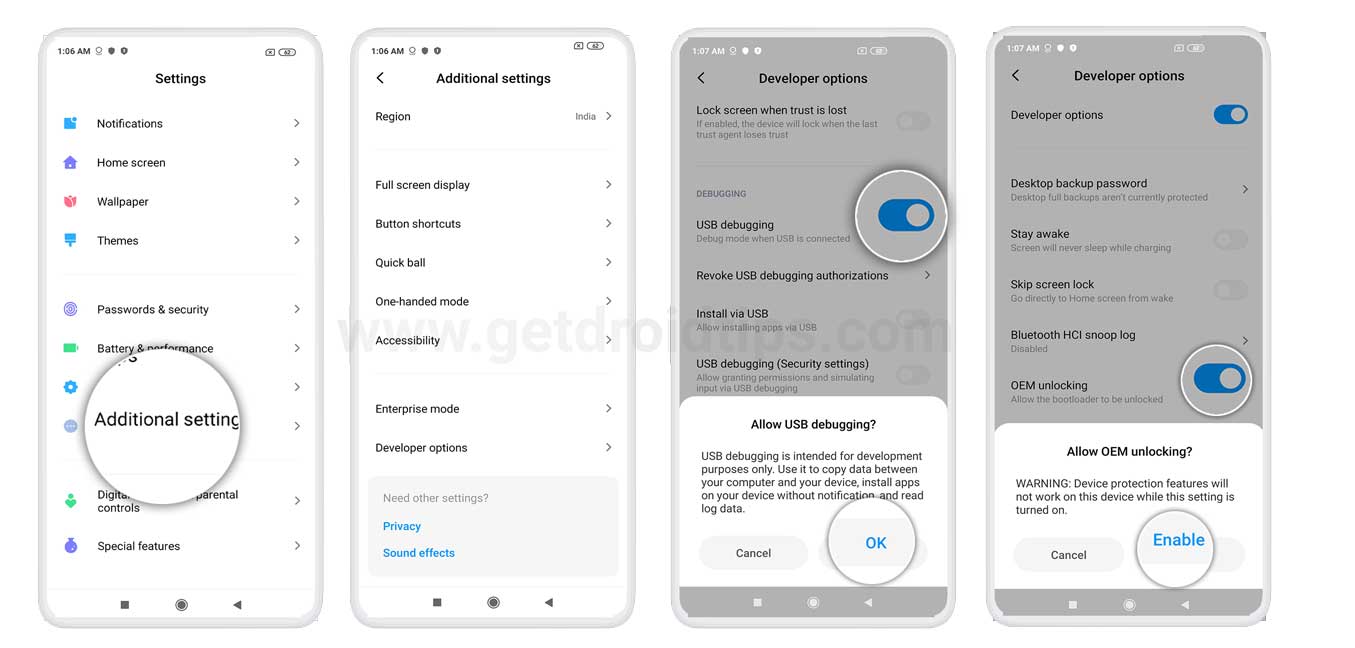
- Now, go back to the Settings menu again and head over to Developer Options. [You may also find it inside the Additional Settings menu]
- Here make sure to turn on the Allow USB debugging and Allow OEM unlocking toggle one by one.
#5. Install Platforms Tools
Make sure to download and install the Android SDK and Platform Tools on your PC that includes necessary ADB and Fastboot files for running commands on the Android device.
#6. Take a full backup of data
Once all is done, just ensure that you’ve done a data backup of your device to the cloud storage or any other external device for safety purposes. Unlocking the bootloader will wipe out the internal device data completely.
Bootloader Unlocking Method:
Here we’ve mentioned the full bootloader unlocking process in a couple of individual steps that you can follow for your ease.
Step 1. Check Bootloader Status
It’s only possible to unlock the bootloader for certain releases that support AOSP developments. To check for the same, you can perform the following steps:
- Open the Dialer app on your Sony Xperia device.
- Enter *#*#7378423#*#* to automatically get into the Service menu.
- Now, tap on Service info > Select Configuration > Then check for Rooting Status.
- If the Bootloader Unlock is allowed on your specific Sony Xperia device then it’ll say Yes.
- Next, follow the second step properly.
Please Note: If Bootloader Unlock status says ‘No’ or the status is missing for the model, then your device cannot be unlocked officially.
Step 2. Install USB Drivers and Platform Tools
- Make sure that you’ve already installed the Sony USB Drivers and the ADB/Fastboot Platform Tools on your computer as mentioned above. If not, do this right now.
- Next, extract or unzip the Platform Tools package on your PC.
- Enable USB debugging and OEM unlocking by following the methods above. This is important.
WARNING! If you perform the bootloader unlocking method, you’ll unlock the bootloader of your device but it’ll also void the manufacturer’s or operator’s warranty (if any). So, GetDroidTips won’t be held any kind of data loss or damage to your phone by following this guide. Do this at your own risk.
Step 3. Connect to Fastboot
- Make sure to switch off your Sony Xperia device.
- Now, connect the USB cable to your computer with the device.
- Press the Power + Volume Up keys for a couple of seconds (also known as the Fastboot key) and connect the other end of the USB cable to the device.
- Windows computer users can open the Devices and Printers directory > Right-click on the fastboot driver > Click on Update > Browse and select the location of the new android_winbus.inf file.
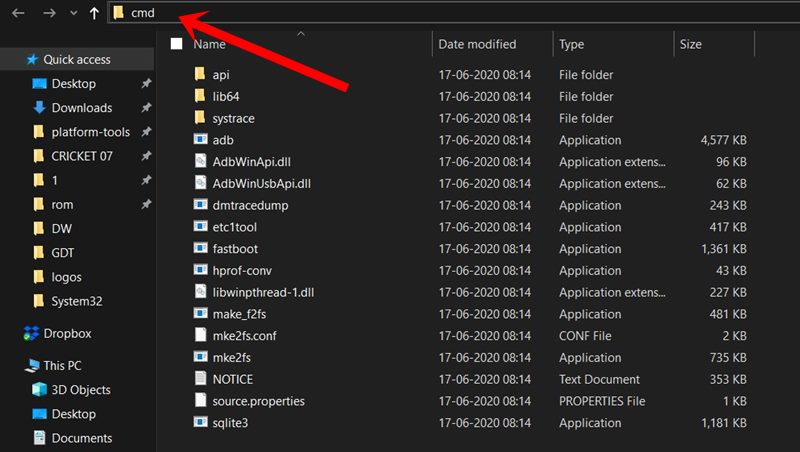
- Once your device is connected to the PC, you’ll need to check the status for the same by running the following command inside the platform-tools folder of Android SDK: [Go to the platform-tools folder > Type CMD in the address bar > Hit Enter to launch the Command Prompt window]
fastboot devices
- Check whether you’re getting any errors while verifying the fastboot connectivity or not. If everything seems okay then follow the next step or retry the full steps from the beginning.
Step 4. Enter Unlock Code
- Now, head over to the official Sony Unlocking Site, and select your device model from the list.
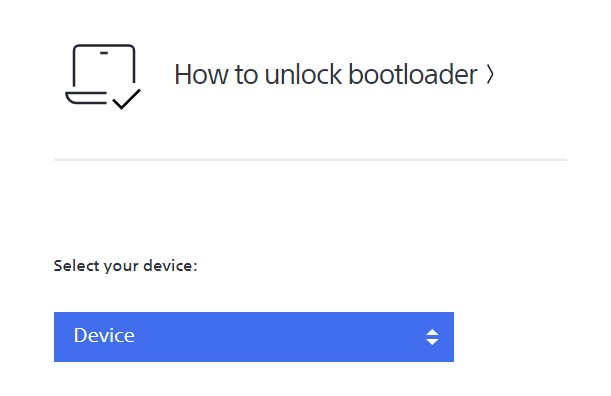
- Open the Dialer app on your phone again and enter *#06# to get the IMEI number.
- Just copy or note down the IMEI number of your device and paste it into the IMEI section of the bootloader unlocking website.
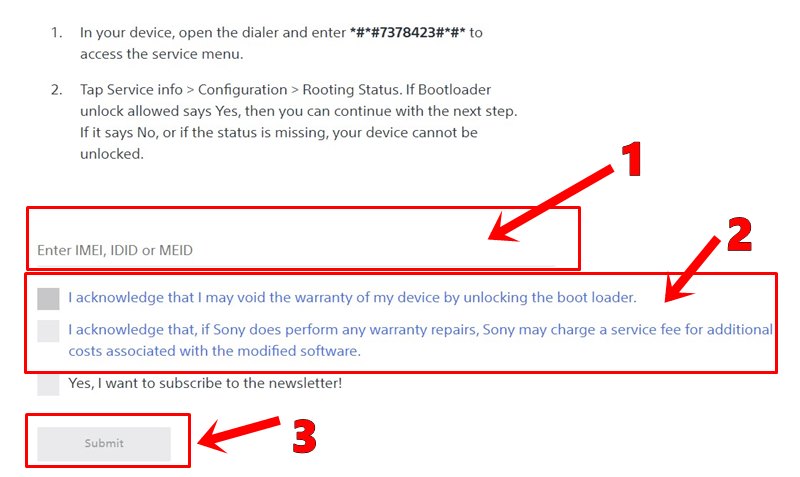
- Do checkmark both the acknowledgments and click on the Submit button to easily get the official Unlock Code for your specific device unit based on the IMEI number. [Keep it in a secured location or folder]
- Now, type in the following command in that command prompt window to boot your device into the fastboot mode:
adb reboot bootloader
- Finally, to unlock the bootloader of your Sony Xperia device, make sure to execute the following command: [Replace <insert your unlock code> part with the Unlock Code without using less than (<) and greater than (>) signs]
fastboot oem unlock 0x<insert your unlock code>
- Check and verify whether the bootloader is unlocked or not. If yes, you’ll get a successful message, and your device will reboot into the system automatically.
- If not rebooted yet, you can execute the following command to do so:
fastboot reboot
- You’re done. You’ve now successfully and officially unlocked the bootloader of your Sony Xperia device.
That’s it, guys. We hope you’ve found this guide useful. For further queries, you can comment below.

What if the Bootloader Unlock status says ‘No’ can it be unlock unofficially?? and if it’s unlockable how ???
Did you get an answer to this matey?
Really need to unlock my boot loader too.
Docomo ekakda?